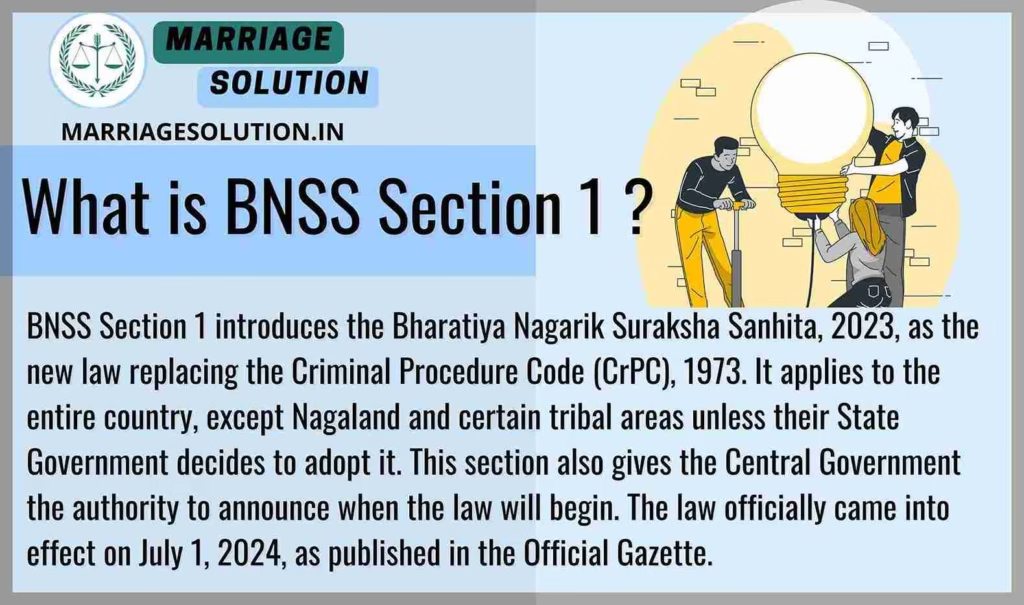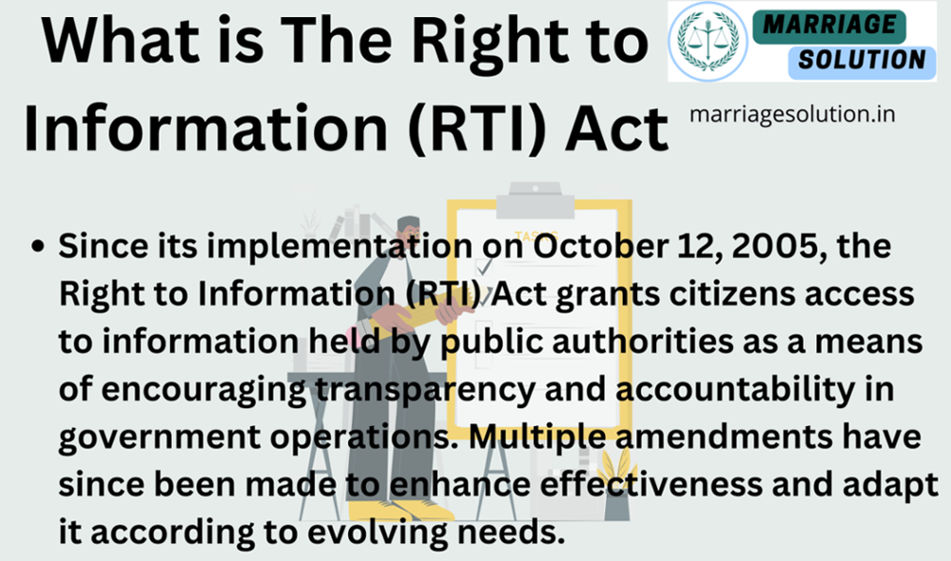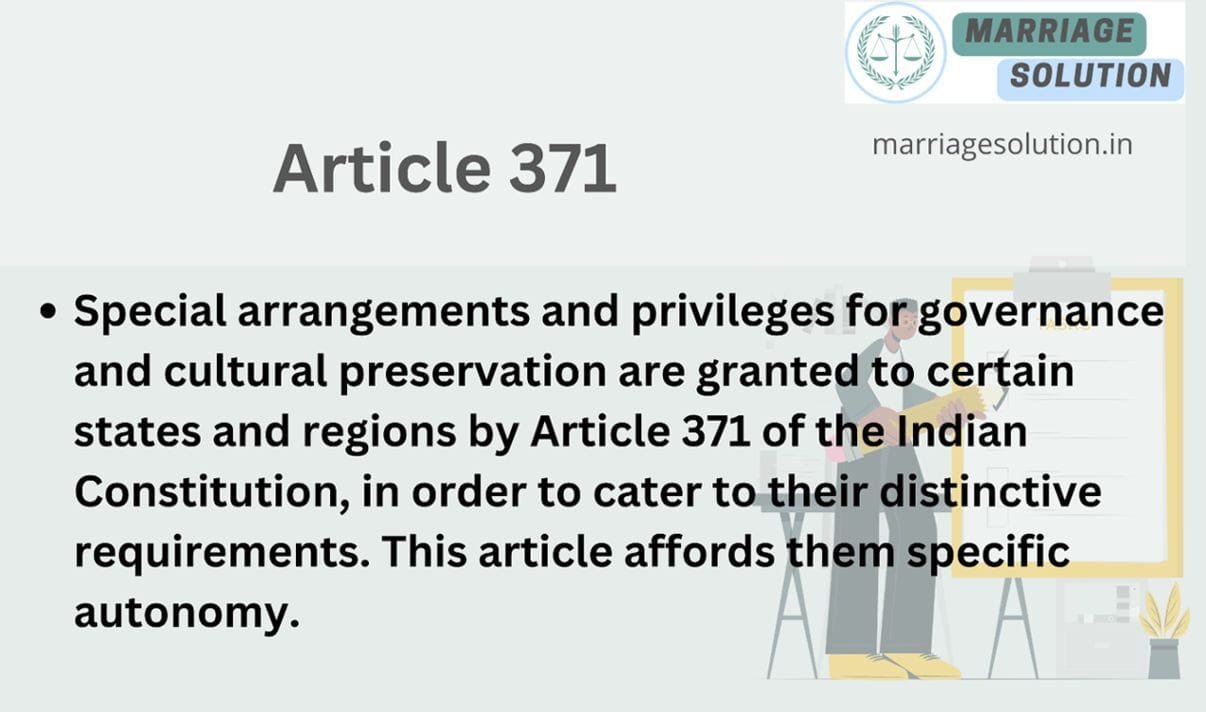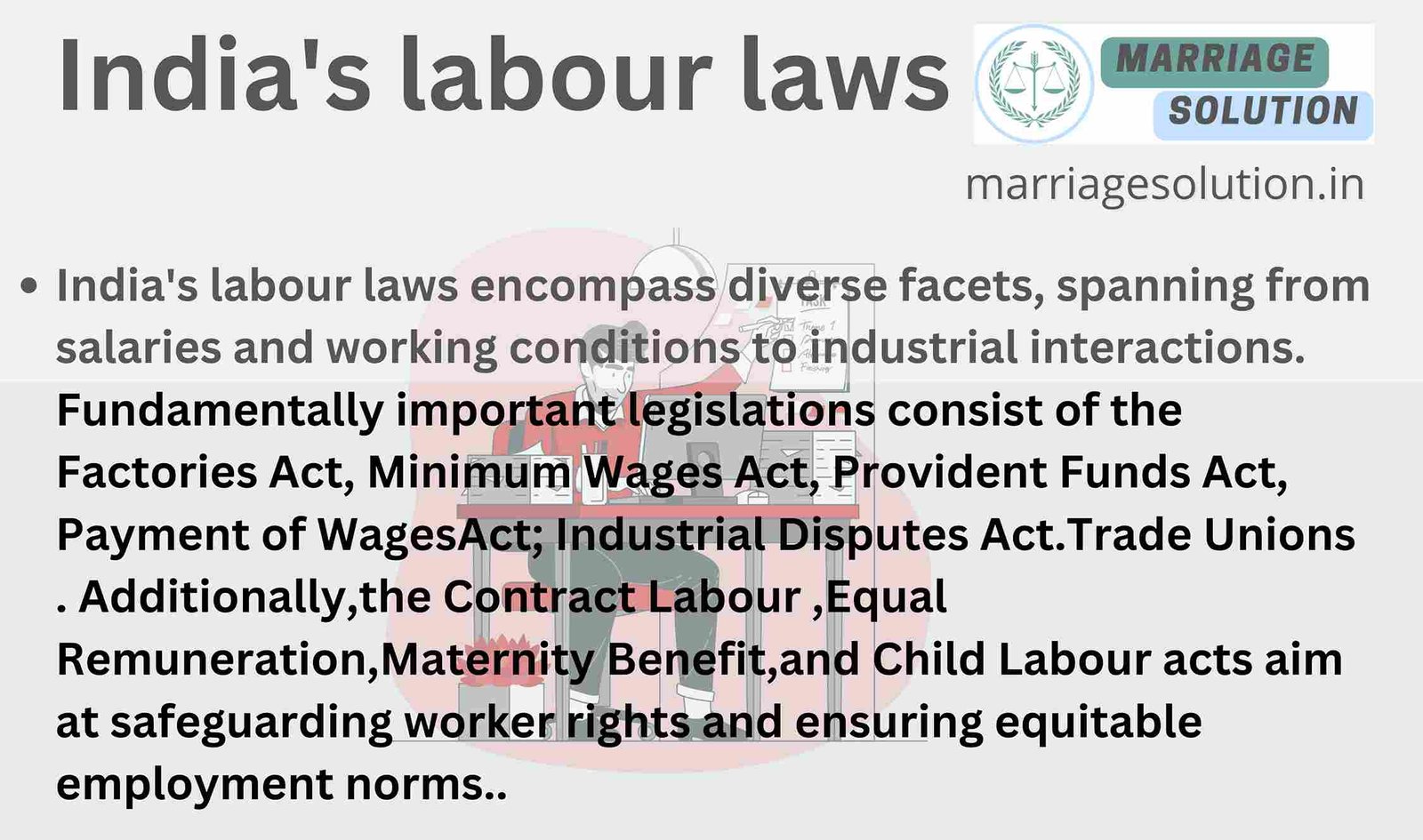Introduction of Section 1 of BNSS
Section 1 of BNSS of the Bharatiya Nagarik Suraksha Sanhita (BNSS), 2023 is the opening part of this new criminal law. It tells us the official name of the law, where it will be applied, and when it will begin. This law has replaced the old Criminal Procedure Code (CrPC), 1973, and became active from July 1, 2024. It is part of India’s major criminal justice reform to modernize outdated British-era laws.
- Introduction of Section 1 of BNSS
- What is BNSS Section 1 ?
- BNSS Section of 1 in Simple Points
- Section 1 of BNSS Overview
- 10 Key Points of BNSS Section 1
- 1. New Law Replacing CrPC, 1973
- 2. Applies to Entire India
- 3. Not Automatically Applied to Nagaland and Tribal Areas
- 4. State Government Can Apply BNSS to Excluded Areas
- 5. Tribal Areas Clearly Defined in the Law
- 6. Central Government Decided the Start Date
- 7. Official Gazette Published the Start Date
- 8. Part of Big Criminal Law Reform of 2023
- 9. Legal Clarity and Simplicity
- 10. Foundation Section of BNSS
- Examples of BNSS Section 1:
- Section 3 of BNSS Short Information
- BNSS Section 1 FAQs
- If you need support with court proceedings or any other legal matters, don’t hesitate to reach out for assistance.
What is BNSS Section 1 ?
BNSS Section 1 introduces the Bharatiya Nagarik Suraksha Sanhita, 2023, as the new law replacing the Criminal Procedure Code (CrPC), 1973. It applies to the entire country, except Nagaland and certain tribal areas unless their State Government decides to adopt it. This section also gives the Central Government the authority to announce when the law will begin. The law officially came into effect on July 1, 2024, as published in the Official Gazette.

BNSS Section of 1 in Simple Points
1. Introduction of the New Law
Section 1 of the BNSS, 2023, introduces a new set of rules for handling criminal cases in India, replacing the older Code of Criminal Procedure (CrPC) of 1973. This means that all procedures related to arrests, investigations, trials, and bail have been updated to be more efficient and citizen-friendly. The goal is to modernize the criminal justice system, making it faster and more in tune with today’s needs. By removing outdated methods from the colonial era, the law aims to provide fair and swift justice to everyone in the country. All law enforcement agencies are required to follow these new procedures.
2. Where the Law Applies
The BNSS is meant to be used all over India, ensuring that criminal procedures are the same in every state and union territory. However, there are exceptions for certain areas like Nagaland and some tribal regions. In these places, the law doesn’t automatically apply because of their unique customs and traditions. But, the local state governments have the option to adopt the BNSS in full or in part by issuing an official notification. This flexibility allows these regions to decide if and how they want to implement the new law, balancing national consistency with respect for local practices.
3. When the Law Starts
Section 1 also specifies when the BNSS will begin to be used. The Central Government has the authority to decide the start date and will announce it through an official notification in the Government Gazette. This approach gives courts, police, and other legal institutions time to prepare for the change. Until the BNSS comes into effect, the existing CrPC rules will continue to be followed. This planned transition helps ensure that the shift to the new system is smooth and doesn’t disrupt ongoing legal processes.
4. Special Provisions for Certain Areas
Recognizing the diverse cultural and administrative setups in India, the BNSS provides special provisions for areas like Nagaland and specific tribal regions. In these places, the law doesn’t apply automatically. Instead, the state governments can choose to implement it by issuing a notification. They can also make necessary changes to the law to better fit local customs and practices. This means that while the BNSS sets a standard for the country, it also allows for adjustments to respect the unique identities of certain regions. This approach ensures that the law is both uniform and adaptable.
5. Purpose of Section 1
Section 1 serves as the foundation for the BNSS by clearly stating the law’s name, where it applies, and when it will start. This clarity helps everyone—citizens, law enforcement, and legal professionals—understand the basic framework of the new law. By defining these key aspects at the beginning, the law sets clear expectations and reduces potential confusion. This organized approach aids in the smooth implementation of the BNSS, ensuring that all stakeholders are on the same page from the outset.
Section 1 of BNSS Overview
BNSS Section 1 defines the short title, extent, and commencement of the Bharatiya Nagarik Suraksha Sanhita, 2023. It states that this law applies to the whole of India, except Nagaland and certain tribal areas unless the concerned state government decides to implement it. It also gives the Central Government the power to notify the date from which the law will come into force, which is July 1, 2024.
10 Key Points of BNSS Section 1
1. New Law Replacing CrPC, 1973
The Bharatiya Nagarik Suraksha Sanhita (BNSS), 2023, is India’s new law that replaces the old Code of Criminal Procedure (CrPC), 1973. This change came into effect from July 1, 2024. The BNSS was created to simplify and modernize criminal procedures like FIR filing, arrests, bail, trials, and investigations. It removes outdated colonial practices and gives priority to citizen safety and speedy justice. With this update, the BNSS became the official criminal procedure law across India, and CrPC is no longer applicable.
2. Applies to Entire India
BNSS now applies to every part of India, including all states and union territories. This includes special regions like Jammu & Kashmir, which earlier had special laws. Now, whether a person is in Tamil Nadu or Himachal Pradesh, the rules for police, courts, and criminal procedures will be the same. This brings uniformity in legal processes and helps people know their rights and duties more clearly. It also makes law enforcement easier across state borders.
3. Not Automatically Applied to Nagaland and Tribal Areas
Even though BNSS applies to all of India, it does not automatically apply to Nagaland and certain tribal areas. These areas have their own customary laws and systems, which are protected under the Constitution of India. So, BNSS respects their traditions and does not forcefully apply criminal procedures there. However, this does not mean they are totally excluded—there is a way for these areas to adopt BNSS if needed, but only if the state government chooses to do so.
4. State Government Can Apply BNSS to Excluded Areas
The government of Nagaland or any state with tribal areas can decide to apply BNSS in those regions by issuing a notification. This decision can include modifications to suit local customs. For example, they may choose to apply only some parts of BNSS or add changes to fit tribal traditions. This flexibility respects local control while still offering the benefits of a modern criminal law system. It allows for gradual and thoughtful legal reforms in sensitive regions.
5. Tribal Areas Clearly Defined in the Law
BNSS clearly explains which areas are called “tribal areas”. These are the areas that were part of Assam’s tribal regions before January 21, 1972, as mentioned in the Sixth Schedule of the Indian Constitution. However, it excludes Shillong Municipality, which will follow BNSS. By defining tribal areas properly, the law avoids confusion and helps in knowing where BNSS applies and where it doesn’t. It also ensures that tribal identity is protected while giving an option to adopt national law.
6. Central Government Decided the Start Date
BNSS did not start on its own. The Central Government officially announced that BNSS would come into force on July 1, 2024. This gave enough time for everyone—police, courts, lawyers, and citizens—to understand the new rules. Training sessions, workshops, and awareness programs were organized in the months before this date. This method of selecting a specific date ensures a smooth transition from CrPC to BNSS without confusion or disruption in ongoing legal matters.
7. Official Gazette Published the Start Date
The start date of BNSS was officially published in the Government Gazette, which is the formal record of all important government announcements. Publishing in the Gazette ensures that the start date is legally valid and publicly known. This is important because laws must be officially notified before they can be enforced. By printing it in the Gazette, everyone—citizens, lawyers, police—got a confirmed and trusted source of information about when BNSS would start working.
8. Part of Big Criminal Law Reform of 2023
BNSS is not just a new law—it is part of a major reform in India’s criminal justice system. Along with BNSS, two other laws were introduced: Bharatiya Nyaya Sanhita (BNS) which deals with crimes, and Bharatiya Sakshya Adhiniyam (BSA) which handles evidence. All three laws were passed in 2023 to replace old British-era laws. These changes aim to make the system faster, fairer, digital-friendly, and victim-centric. BNSS mainly deals with how criminal cases are handled step by step.
9. Legal Clarity and Simplicity
Section 1 of BNSS provides clear and simple information about the law. It tells us the name of the Act, where it applies, when it starts, and where it does not apply. This gives full legal clarity and avoids doubts. From July 1, 2024, CrPC has no legal force—BNSS must be followed. All police stations, courtrooms, and legal institutions must now refer to BNSS for procedures. This clarity helps law students, police officers, and citizens understand and follow the law better.
10. Foundation Section of BNSS
Section 1 is the foundation or base of the entire BNSS law. Just like a book starts with a title page and introduction, this law starts with Section 1 to explain the basics. It sets the legal boundary and purpose of the law. The remaining chapters and sections of BNSS will only make sense if this first part is understood. It acts like the starting point of a journey, guiding readers and legal experts on what the law is, where it applies, and how it begins.
Examples of BNSS Section 1:
🔹 Example 1:
After July 1, 2024, if a police officer in Delhi wants to make an arrest or file a chargesheet, they will follow the rules written in BNSS instead of the old CrPC.
🔹 Example 2:
In Nagaland, BNSS will not automatically apply unless the Nagaland government issues a notification to adopt it. This protects tribal customs unless they choose to follow the new law.
Section 3 of BNSS Short Information
| BNSS Section 1 | Details |
|---|---|
| Section Name | BNSS Section 1 – Short Title, Extent, and Commencement |
| Law Name | Bharatiya Nagarik Suraksha Sanhita, 2023 |
| Replaces | Code of Criminal Procedure (CrPC), 1973 |
| Applies To | All of India |
| Exceptions | Nagaland and certain tribal areas (unless the state government notifies) |
| Start Date | 1st July 2024 |
| Declared By | Central Government (via Official Gazette notification) |
| Purpose of Section | To define the name, area of application, and effective date of the BNSS law |
| Part of | India’s 2023 Criminal Law Reforms |
| Special Notes | State can apply it to tribal areas with changes through notification |
BNSS Section 1 FAQs
BNSS Section 1
Why are Nagaland and certain tribal areas excluded from the automatic application of the BNSS, 2023?
If you need support with court proceedings or any other legal matters, don’t hesitate to reach out for assistance.
Court or any other marriage-related issues, our https://marriagesolution.in/lawyer-help-1/ website may prove helpful. By completing our enquiry form and submitting it online, we can provide customized guidance to navigate through the process.
Right to Information RTI act :Your Comprehensive Guide (Part 1)
The Right to Information (RTI) Act : Explore the essence of the Right to Information (RTI) Act through this symbolic image. The image features legal documents, emphasizing the importance of transparency and accountability in governance. The scales of justice represent…
What is Article 371 of Indian Constitution ?
Article 371 of the Indian Constitution grants special provisions to specific states and regions within India, addressing their unique historical, social, and cultural circumstances. These provisions aim to accommodate diverse needs and protect cultural identities within the constitutional framework.
Indian Labour law : Your Comprehensive Guide (Part 1)
The purpose of labour laws is to safeguard employees and guarantee equitable treatment at the workplace, encompassing aspects such as remuneration, security, and perks. These regulations establish a secure ambiance by imposing minimum wage requirements, ensuring factory safety measures are…
GST :Your Comprehensive Guide (Part 1 – Understanding the Basics)
The Goods and Services Tax (GST) is like a big change in how we pay taxes in India. It started on July 1, 2017, and it’s here to simplify things. Before GST, we had many different taxes, and it could…





